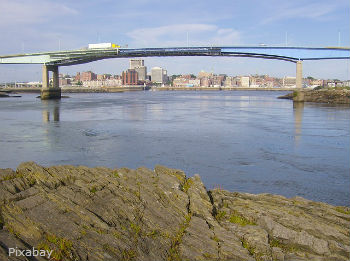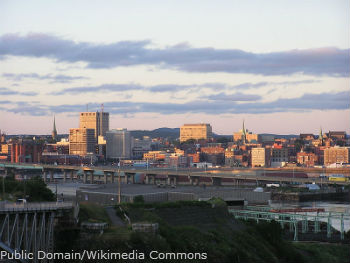Saint John (not to be confused with St. John’s) was Canada’s first incorporated city and is known for its maritime, Irish and Loyalist history.  It is New Brunswick's biggest city and the only town on the Bay of Fundy, where the amazing “Reverse Rapids” phenomenon takes place.
If you are interested in moving to “Canada's Most Irish City,” keep reading to learn more.
Saint John Climate
Saint John has a humid continental climate that is slightly tempered by its coastal location. The city is right on the Bay of Fundy, which takes some of the bite out of the low winter temperatures. The average winter day is about -8 degrees Celsius.
Summers are warm, but rarely hot--the Bay of Fundy once again moderates the temperature. Summer highs are usually around 25 and almost never exceed 30.
Precipitation is common throughout the year, but sees a slight uptick in fall and winter. Snowfall can occasionally be heavy, but winter thaws are possible, too.
Saint John Neighbourhoods
Saint John's many distinct neighbourhoods have historic and ethnic ties to particular locations and demographics. The city has a famously high population of Irish immigrants, but it also has a strong English and Scottish background.
Saint John’s central business district is in the neighbourhood known to locals as “Uptown.” This area would be called “Downtown” in most cities and it is at the south end of the Central Peninsula. The name “Uptown” came to be because most of the area is physically on a hill and if you’re arriving from the harbour, you have to go “up” to town.
The northern part of the Central Peninsula has a handful of neighbourhoods separated by highways. Things can be starkly different once these boundaries are crossed. Some neighbourhoods are urban and poor while others, like Mount Pleasant or Milledgeville, are suburban and upper-middle class.
The neighbourhoods on the west side of the Saint John River are collectively “The West Side,” but locals distinguish smaller neighbourhoods like Carleton, Lancaster and Fairville within the area.
Registering Your Car in Saint John
When you move to a new province, you have to register your vehicle there after a short grace period. If that’s the case for your move to Saint John, you will need to get your car registered with the New Brunswick government. To apply for registration, you need your license, current registration and a credit card. For more details on New Brunswick registration requirements, head to Service New Brunswick. Saint John Transportation Saint John Transportation
Saint John Transit provides the city’s residents with public bus service routes within town. Many of Saint John’s intercity rail and bus services have been discontinued in recent years. Trains still serve the city, but usually only for freight.
The city’s famous maritime transportation now mostly consists of ferry routes and visiting cruise vessels. Each year, roughly 200,000 cruise ship passengers spend some time docked in the Port of Saint John.
Saint John Airport serves the city, but it is not a large international airport and its only major airline is Air Canada. Saint John’s nearest international airport is the Greater Moncton International Airport, which is over 140 kilometres away.
Saint John Schools
Only two public school boards have facilities in Saint John. District 8 runs the city’s English-speaking facilities, including Canada’s oldest public school, Saint John High School. Meanwhile, District 1 oversees the city’s single francophone school.
Saint John does not have any original post-secondary institutions but it is home to several satellite campuses for universities that are based elsewhere. New Brunswick Community College has one of its several province-spanning campuses in Saint John. The University of New Brunswick created UNB Saint John as a satellite campus in 1964, and it has been expanding ever since. It is now one of the city’s biggest employers. Additionally, Dalhousie Medical School added their own satellite campus within UNB Saint John in 2010.
Saint John Economy
Historically a huge port city and ship-building centre, Saint John is now more diversified with the tourism and service industries gaining traction against old maritime businesses.
Despite diminished importance, the Port of Saint John is still a major economic force for the city. Some of the leading resources shipped in and out of the port are potash and steel. Cruise ships depart and arrive at the port as well.
The tourists that come into Saint John may be the city’s most valuable maritime commodity. The tourism industry revitalized the Uptown area --many new hotels, small businesses, theaters and art galleries have opened in the past decade.
Other important Saint John companies include:
- Irving Oil Refinery: Canada’s largest oil refinery.
- Moosehead Brewery: Canada’s only brewery with nationwide distribution.
- Horizon Health Network: This company runs five hospitals in Saint John.
Saint John’s Cost of Living
Living expenses in Saint John are quite low, but this advantage is partially offset by its similarly low per capita disposable income. If you do find a high-paying job in the city, living in Saint John is a great bargain.
Real estate prices are especially affordable with some of the lowest rates in any Canadian city. As of 2015, a one-bedroom apartment can cost as little as $500 a month on the outskirts of Saint John.
Groceries and utilities are not expensive, but they are more in line with similarly-sized Canadian cities.
Saint John Culture and Contemporary Life
Saint John’s culture has always been defined by its location on the Bay of Fundy. As the Port of Saint John’s main purpose shifted from shipbuilding to receiving cruise liners, the city has built up new attractions for visitors and residents alike.
Saint John is sometimes referred to  as the “Loyalist City” because it was a strategic destination for disenchanted American Loyalists during the American Revolution. This Loyalist history is reflected in Saint John’s architecture and landmarks. Many of the city’s buildings maintain their historic colonial style--for example, the Imperial Theatre was restored to its original colonial aesthetic in the 1980s as a National Historic Site. Another historic attraction is the Saint John City Market. This indoor farmers market is the oldest of its kind in Canada and is also a designated National Historic Site.
The Reverse Falls (or Reverse Rapids) is a unique Saint John phenomenon. The Saint John River's current actually goes in the opposite direction of its regular flow because of the Bay of Fundy's powerful tides. This popular attraction is accompanied by another iconic Saint John landmark--the Loyalist Man. This large cut-out sign depicts a Loyalist from the American Revolutionary War happily welcoming you to Saint John or the Reverse Falls.
Saint John also has several museums for tourists and residents to explore. The New Brunswick Museum is one of the biggest venues in Saint John and has a rich history dating back to its completion in 1934. Uptown Saint John also is home to several newer and smaller museums and art galleries.
Saint John Moving Resources
Have you decided that Saint John is right for you? You can’t move all of your things alone, so you'll need to contact moving companies in the Saint John area. Our database of moving companies can perform any moving service you need. Remember to get at least three quotes from different companies so you know that you are paying a fair price.
Saint John Relocation Tips
- If you can find a good job, Saint John is very affordable due to its low living expenses.
- People who live in the city are called “Saint Johners.”
- Some residents complain of poor drinking water quality in the city.
Helpful Links
|